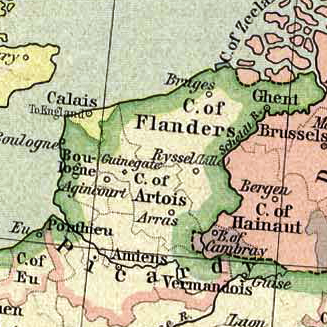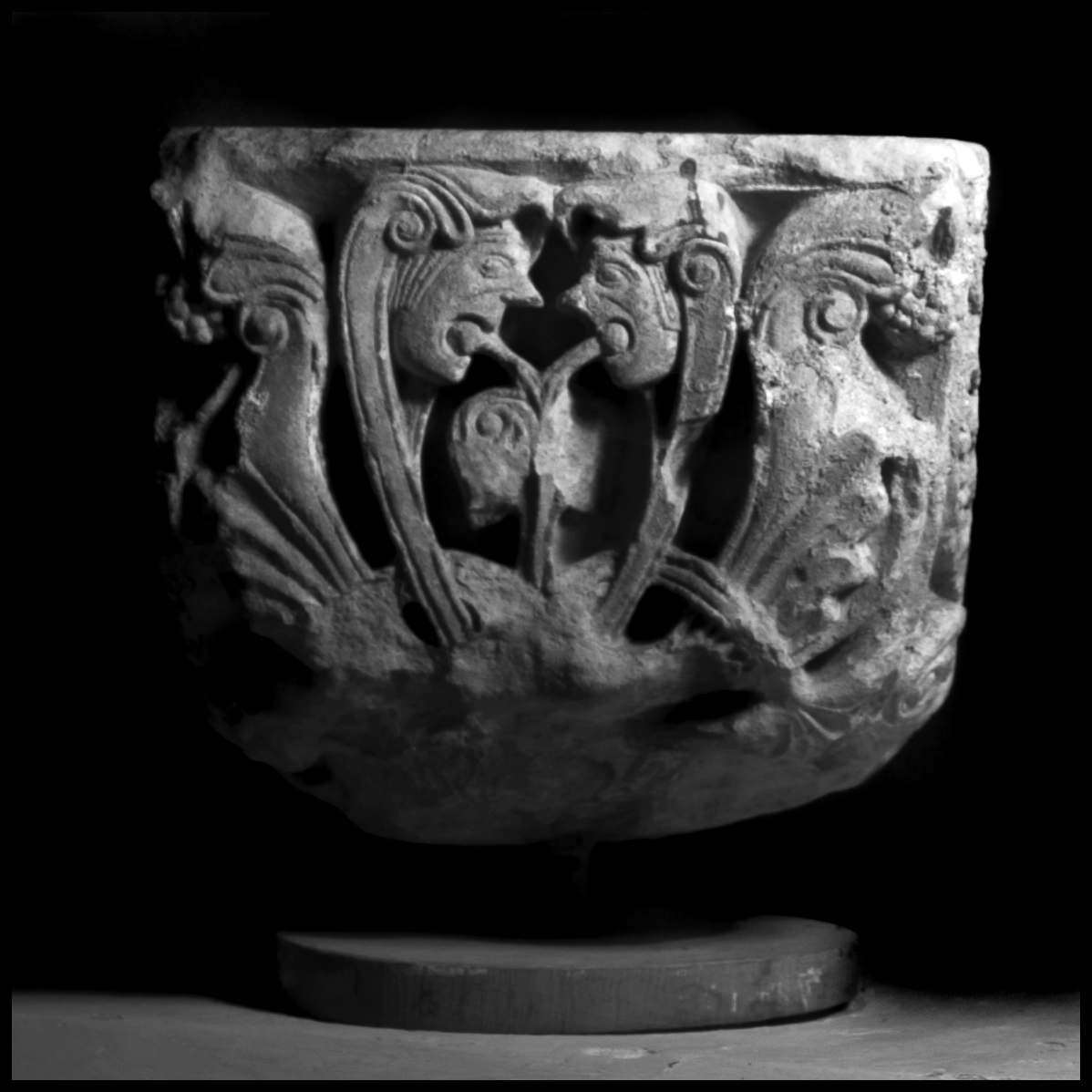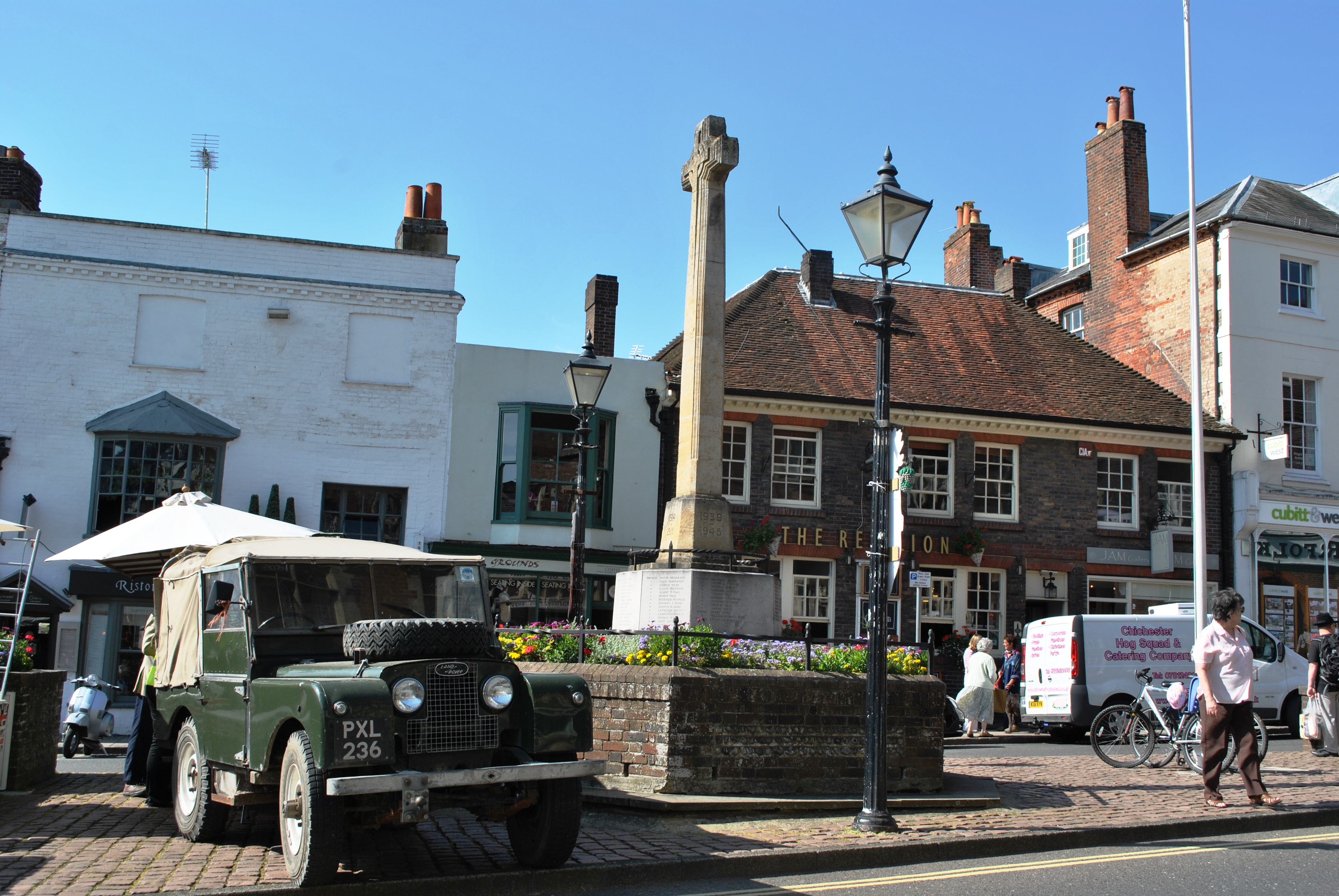|
William FitzAlan, Lord Of Oswestry
William FitzAlan (1085–1160) was a nobleman of Breton ancestry. He was a major landowner, a Marcher lord with large holdings in Shropshire, where he was the Lord of Oswestry, as well as in Norfolk and Sussex. He took the side of Empress Matilda during the Anarchy and underwent considerable hardship in the Angevin cause before regaining his lands and former status. William's younger brother, Walter fitz Alan (d. 1177), became ancestor of the royal House of Stuart. Background and early life William was born around 1085. He was the eldest son and heir of Alan fitz Flaad, a Breton noble whose family were closely associated with the sacred environs of Dol-de-Bretagne, close to the border with Normandy and a short distance south-west of the great abbey of Mont Saint-Michel. Alan was a close ally of Henry I of England (1100-1135), who was determined to insert reliable supporters into strategically key areas after the disloyalty of Robert of Bellême, 3rd Earl of Shrewsbury, who ... [...More Info...] [...Related Items...] OR: [Wikipedia] [Google] [Baidu] |
Isabella De Say
Isabella de Say ( 1132 – 1199) was an Anglo-Norman heiress. Isabella was the only surviving child of Helias de Say upon his death in 1165; Helias was the third lord of Clun, a powerful Norman stronghold in Shropshire, England, along the Welsh border. She is notable for helping to create the powerful medieval house of the FitzAlans. Isabella married William FitzAlan, the lord of nearby Oswestry, as his second wife in 1156. William died in 1160, leaving a son by his first wife, Christiana, William FitzAlan II. Isabella passed Clun Castle to him. The combined lordship of Oswestry and Clun was a significant power in the borderlands with Wales.Brown, p.93. Isabella had married Geoffrey de Vere II, brother of the earl of Oxford by early 1166. After de Vere's death in 1170 she married William Boterel, probably by 1175, the year her stepson William reached his majority. She was certainly married to him by 1188. Isabella's death date is disputed, but she probably lived to 1199. Robert ... [...More Info...] [...Related Items...] OR: [Wikipedia] [Google] [Baidu] |
Mont Saint-Michel
Mont-Saint-Michel (; Norman: ''Mont Saint Miché''; ) is a tidal island and mainland commune in Normandy, France. The island lies approximately off France's north-western coast, at the mouth of the Couesnon River near Avranches and is in area. The mainland part of the commune is in area so that the total surface of the commune is . , the island has a population of 29.Téléchargement du fichier d'ensemble des populations légales en 2019 INSEE The commune's position—on an island just a few hundred metres from land—made it accessible at low tide to the many ... [...More Info...] [...Related Items...] OR: [Wikipedia] [Google] [Baidu] |
High Sheriff Of Shropshire
This is a list of sheriffs and high sheriffs of Shropshire The high sheriff, sheriff is the oldest secular office under the Crown. Formerly the high sheriff was the principal law enforcement officer in the county but over the centuries most of the responsibilities associated with the post have been transferred elsewhere or are now defunct so that its functions are now largely ceremonial. From 1204 to 1344 the Sheriff of Staffordshire served also as the Sheriff of Shropshire. Under the provisions of the Local Government Act 1972, on 1 April 1974 the office previously known as sheriff was retitled high sheriff. The high sheriff changes every March. Sheriff 11th century * Warin the Bald *c. 1086 Rainald De Balliol, De Knightley (1040–1086) *1102 Hugh (son of Warin) 12th century *-1114: Alan fitz Flaad (died 1114) *1127–1137: Pain fitzJohn (died 1137) *1137–1138: William Fitz Allan, Lord of Oswestry, William Fitz Alan (exiled 1138) *1155–1159: William Fitz Allan, Lord of ... [...More Info...] [...Related Items...] OR: [Wikipedia] [Google] [Baidu] |
First Crusade
The First Crusade (1096–1099) was the first of a series of religious wars, or Crusades, initiated, supported and at times directed by the Latin Church in the Middle Ages. The objective was the recovery of the Holy Land from Muslim conquest of the Levant, Islamic rule. While Jerusalem had been under Muslim rule for hundreds of years, by the 11th century the Seljuk Empire, Seljuk takeover of the region threatened local Christian populations, pilgrimages from the West, and the Byzantine Empire itself. The earliest initiative for the First Crusade began in 1095 when List of Byzantine emperors, Byzantine emperor Alexios I Komnenos requested military support from the Council of Piacenza in the empire's conflict with the Seljuk-led Turks. This was followed later in the year by the Council of Clermont, during which Pope Urban II supported the Byzantine request for military assistance and also urged faithful Christians to undertake an armed pilgrimage to Jerusalem. This call was met ... [...More Info...] [...Related Items...] OR: [Wikipedia] [Google] [Baidu] |
Gloucestershire
Gloucestershire ( , ; abbreviated Glos.) is a Ceremonial counties of England, ceremonial county in South West England. It is bordered by Herefordshire to the north-west, Worcestershire to the north, Warwickshire to the north-east, Oxfordshire to the east, Wiltshire to the south, Bristol and Somerset to the south-west, and the Wales, Welsh county of Monmouthshire to the west. The city of Gloucester is the largest settlement and the county town. The county is predominantly rural, with an area of and a population of 916,212. After Gloucester (118,555) the largest distinct settlements are Cheltenham (115,940), Stroud (26,080), and Yate (28,350). In the south of the county, the areas around Filton and Kingswood, South Gloucestershire, Kingswood are densely populated and part of Bristol Built-up Area, Bristol built-up area. For Local government in England, local government purposes Gloucestershire comprises a non-metropolitan county, with six districts, and the Unitary authorities ... [...More Info...] [...Related Items...] OR: [Wikipedia] [Google] [Baidu] |
Staffordshire
Staffordshire (; postal abbreviation ''Staffs''.) is a Ceremonial counties of England, ceremonial county in the West Midlands (region), West Midlands of England. It borders Cheshire to the north-west, Derbyshire and Leicestershire to the east, Warwickshire to the south-east, the West Midlands (county), West Midlands county and Worcestershire to the south, and Shropshire to the west. The largest settlement is the city of Stoke-on-Trent. The county has an area of and a population of 1,131,052. Stoke-on-Trent is located in the north and is immediately adjacent to the town of Newcastle-under-Lyme. Stafford is in the centre of the county, Burton upon Trent in the east, and the city of Lichfield and Tamworth, Staffordshire, Tamworth in the south-east. For local government purposes Staffordshire comprises a non-metropolitan county, with nine districts, and the Unitary authorities of England, unitary authority area of Stoke-on-Trent. The county Historic counties of England, historical ... [...More Info...] [...Related Items...] OR: [Wikipedia] [Google] [Baidu] |
County Of Flanders
The County of Flanders was one of the most powerful political entities in the medieval Low Countries, located on the North Sea coast of modern-day Belgium and north-eastern France. Unlike the neighbouring states of Duchy of Brabant, Brabant and County of Hainaut, Hainaut, it was within the territory of the France in the Middle Ages, Kingdom of France. The counts of Flanders held the most northerly part of the kingdom, and were among the original twelve Peerage of France#Under the Monarchy: feudal period and Ancien Régime, peers of France. For centuries, the economic activity of the Flemish cities, such as Ghent, Bruges and Ypres, made Flanders one of the most affluent regions in Europe, and also gave them strong international connections to trading partners. Up to 1477, the core area under French suzerainty was west of the Scheldt and historians call this "Royal Flanders" (Dutch: ''Kroon-Vlaanderen'', French: ''Flandre royale''). Aside from this, the counts, from the 11th centu ... [...More Info...] [...Related Items...] OR: [Wikipedia] [Google] [Baidu] |
Artois
Artois ( , ; ; Picard: ''Artoé;'' English adjective: ''Artesian'') is a region of northern France. Its territory covers an area of about 4,000 km2 and it has a population of about one million. Its principal cities include Arras (Dutch: ''Atrecht''), Saint-Omer, Lens, and Béthune. It is the eponym for the term ''Artesian''. Location Artois occupies the interior of the Pas-de-Calais ''département'',"Artois" in '' The New Encyclopædia Britannica''. Chicago: Encyclopædia Britannica Inc., 15th ed., 1992, Vol. 1, p. 607. the western part of which constitutes the former Boulonnais. Artois roughly corresponds to the arrondissements of Arras, Béthune, Saint Omer, and Lens, and the eastern part of the arrondissement of Montreuil. It occupies the western end of the coalfield which stretches eastward through the neighbouring Nord ''département'' and across central Belgium. History Originally a feudal county itself, Artois was annexed by the county of Flanders. I ... [...More Info...] [...Related Items...] OR: [Wikipedia] [Google] [Baidu] |
Hesdin
Hesdin (; ) is a former Communes of France, commune in the Pas-de-Calais Departments of France, department in northern France. On 1 January 2025, it was merged into the new commune of Hesdin-la-Forêt. Geography The N39, from Arras to Montreuil, Pas-de-Calais, Montreuil, used to be the main thoroughfare of the town. In the 1950s, a circular route was created to help traffic flow. A second bypass was built in the 1980s, taking all through traffic well away from the town centre. The Canche river flows through the centre of Hesdin. History Hesdin was a fief of the counts of Artois, vassals of the Count of Flanders, Counts of Flanders until 1180. When Philip I, Count of Flanders, Philip, count of Flanders gave Artois as dowry to his niece Isabella of Hainault when she married Philip Augustus of France in 1180, Hesdin and the other seigneuries passed to France. At the end of the 11th century, Hesdin gained renown for the Hesdin Castle, park and chateau of Robert II, Count of Artoi ... [...More Info...] [...Related Items...] OR: [Wikipedia] [Google] [Baidu] |
Arnulf
Arnulf is a masculine German given name. It is composed of the Germanic elements ''arn'' "eagle" and ''ulf'' "wolf". The ''-ulf, -olf'' suffix was an extremely frequent element in Germanic onomastics and from an early time was perceived as a mere suffix forming given names. Similarly, the suffix ''-wald, -ald, -old'', originally from ''wald'' "rule, power" underwent semantic weakening. Therefore, the name ''Arnulf'' and '' Arnold'' were often conflated in early medieval records, as is the case with bishop Arnulf of Metz (died 640), especially as the final consonant came to be dropped (''Arnoul''). The name ''Arnulf'' is attested from as early as the 5th century, as the name of the brother of Odoacer. The name is attested with some frequency in Medieval Germany throughout the 8th to 11th centuries, in the spelling variants ''Arnulf, Arnulph, Arnolf'', occasionally also as ''Arenulph, Harnulf, Harnolf, Harnolph''. In the 9th century, Arnulf of Carinthia was the ruler of East Franc ... [...More Info...] [...Related Items...] OR: [Wikipedia] [Google] [Baidu] |
Ernulf De Hesdin
Ernulf de Hesdin (died 1097), also transcribed as ''Arnulf'' and ''Ernulphe'', was a French knight who took part in the Norman conquest of England and became a major landholder under William the Conqueror and William Rufus, featuring prominently in the Domesday Book. He was disgraced as a suspected rebel and died while taking part in the First Crusade as part of the army of Robert Curthose. Origins As his sobriquet implies, Ernulf was probably born in the first half of the 11th century in the County of Hesdin, historically part of Picardy or Artois and centred at that time on Vieil-Hesdin, then a flourishing fortified town known as Hesdin on the bank of the Canche river, about 6 km from modern Hesdin. His family were minor landholders, vassals of the Counts of Hesdin, whose overlord was the Count of Flanders, through acquisition by marriage of the County of Artois circa 898. The first Count of Hesdin who is definitely known through chronicles was Alulf I, who flourished ... [...More Info...] [...Related Items...] OR: [Wikipedia] [Google] [Baidu] |
Arundel
Arundel ( ) is a market town and civil parish in the Arun District of the South Downs, West Sussex, England. The much-conserved town has a medieval castle and Roman Catholic cathedral. Arundel has a museum and comes second behind much larger Chichester in its number of listed buildings in West Sussex. The River Arun runs through the eastern side of the town. Arundel was one of the boroughs reformed by the Municipal Reform Act 1835. From 1836 to 1889 the town had its own Borough police force with a strength of three. In 1974 it became part of the Arun district, and is now a civil parish with a town council. Name The name comes from the Old English ''Hārhūnedell'', meaning "valley of horehound", and was first recorded in the Domesday Book. Folk etymology, however, connects the name with the Old French word ''arondelle'', meaning "swallow", and swallows appear on the town's arms. Governance An electoral ward of the same name exists. This ward stretches north to Ho ... [...More Info...] [...Related Items...] OR: [Wikipedia] [Google] [Baidu] |





